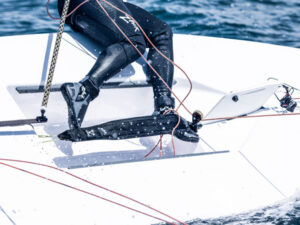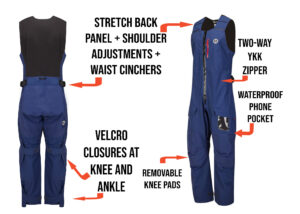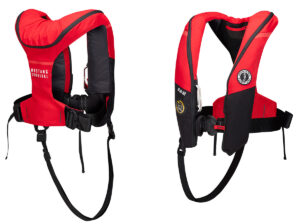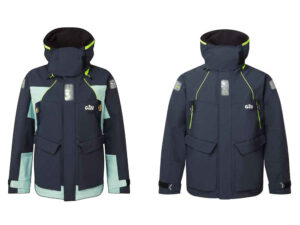I’ve never owned an outboard of any kind, relying instead on my skills, which eventually get me back to safe harbor when sailing dinghies or the magazine’s communal 27-foot harbor booze cruiser. The unwritten rule is to not pass Point A or Point B. Factor in the tidal flow and wind forecast and I’ll be fine. No propulsion. No problem.
But here I am, on the early morning of November 16, clamping an ePropulsion Spirit 1.0 Plus demo unit onto the back of my wagon-red O’Day Widgeon, a 12-foot, 200-pound sloop built in 1971. As I tighten the bracket vise screws, white gelcoat on the inside of the transom collapses in radiating circle cracks. The subtle crunching sound sends a memo to my brain: “Build a backing plate this winter.”
With both screws snug, I stand back to behold this intriguing piece of modern technology hanging off the back of a low-tech classic sailboat. Its blue twin-bladed propeller sits on the trailing point of the torpedo-shaped lower unit that houses the direct-drive motor. The slim 25-inch grey aluminum alloy shaft (the “short” model) terminates at the battery case, now empty. This regular-length model is a perfect fit for this little boat, with a transom height of 17 inches.
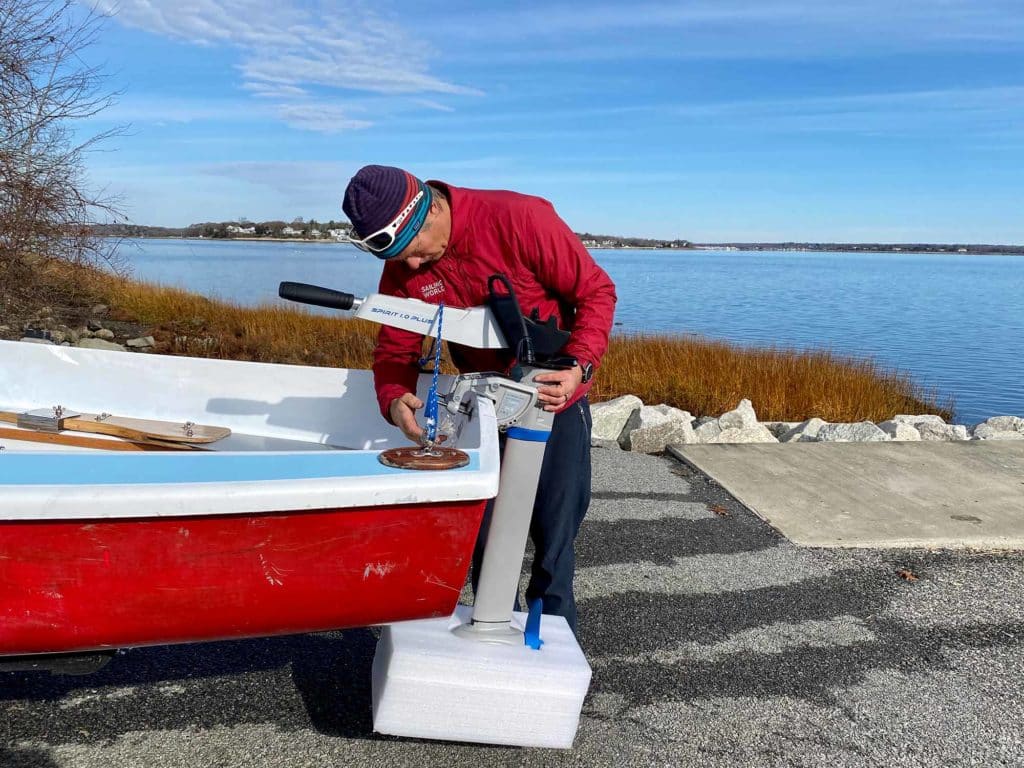
I retrieve the ePropulsion’s brand new battery from the car. I’ve had it on the wall charger for a few days (instructions say 8.5 hours to full charge), so it’s topped-off and fresh. I carry it by its big handle to the boat and slide it into its cradle. The battery is only 20 pounds, and according to its maker, Guangdong Epropulsion Technology, Ltd., it actually floats (there’s a video to prove it). A spring-loaded latch secures it in place. I plug in the metallic power cable connector, straighten the integrated folding tiller and hold the power button for a few seconds. When the display goes live, showing runtime hours remaining and wattage, I rotate the throttle toward me; there’s a pause and then the motor whirs to life.
“Wow. That’s quiet,” my wife says.
“Yeah. I think that’s the point,” I respond. “Pretty cool, huh?”
I turn to Mount Hope Bay and note its mirror-like state, reflecting a muted blue sky and high Cirrus clouds veiling the sun. “We’ll definitely need it,” I say with a chuckle.
The day’s adventure destination is the Kickemuit River basin, a wide tidal flat in Bristol, Rhode Island. I’ve always wanted to check it out. It’s famous in a Rhode Island sort of way; a mile at most at its widest point, tree-lined and shallow, but fully protected. It’s a perfect place for small-boat sailing, anchoring and hurricane-holing, but the kicker is there’s only way in from the outside: a sharply curved and narrow channel. When the tide is in full flow, channel markers strain against the rip, laying back with a gurgling wake steaming behind. Right now, the ebb tide is on the move and the wind is forecast to build from the southeast, ahead of one big final leave-stripping cold front.
We step the Widgeon’s rig on the trailer, pin it, bend the sails on and slip the boat into the bay. With no wind, we don’t bother raising the sails. We’ll let this $2,000, 3-horsepower electric outboard deliver us to our sailing grounds, where we’ll explore while we wait for the wind. We drift off the dock and I coax the throttle toward me. I hear a gurgling bow wake before I can even hear the whine of the motor below the surface. The thrust is noticeable and our takeoff speed is excellent. Seconds later, I’m at full throttle, doing 3.5 knots, according to the GPS readout on my Garmin Quatix Watch.
Water rushes past the hull, swishing and gurgling, our apparent wind whispers across my ears. It’s the sound of freedom; freedom to quietly explore and play on an empty bay, social distanced, breathing fresh air and escaping the anxiety of a pandemic, a contested election and the impending arrival of another New England winter. While at full speed, my wife and I carry on a conversation; we talk about our two kids that we’ve left at home with a promise we’d be back in two hours. She wishes she brought her binoculars because the silence of the outboard would allow us to ease closer to shorebirds without spooking them.
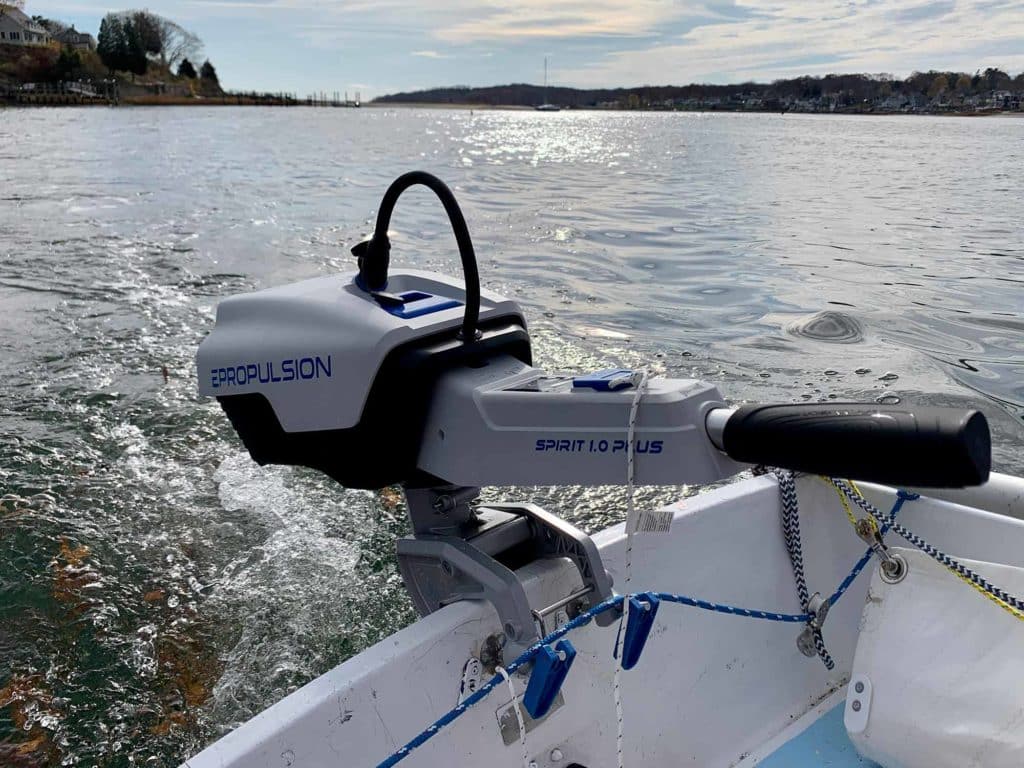
As we nose into the heart of the current, the shoreline view is slow to change. I look at my watch—1.5 knots—and then at the readout on the tiller’s LCD display. One bar is gone already from the dashed circle that illustrates my remaining power. It tells me I have an hour of run time left at this full-throttle wattage consumption.
According to the manufacturers specs, this ePropulsion Spirit 1.0 Plus will give me one hour and 15 minutes at full throttle, five hours at half throttle, and 13 hours at trolling speed. But this is a Bay of Fundy kind of current we’re steaming into and there’s no escaping to shallow sides in this channel. It’s all deep water and it’s running fast, but the motor keeps doing its thing as the world passes slowly by. After a few anxious minutes of wondering if the current will win this power battle, we’re into wider water and our speed over the ground returns to normal.
Because the outboard is best mounted on centerline, I can’t hang the Widgeon’s rudder from its gougeons until we pick up a mooring to remove the motor and raise sails. I pull up on a small blue handle atop the battery casing and it releases the battery. Luckily, it fits wedged between the forward cockpit walls and the centerboard trunk. I remove the rest of the unit and gently guide it prop first into a small cuddy cutout and rest the prop on a lifejacket. The upper bracket is too big, so it sticks out. It’s not ideal, but it’s not bad either. It’s out of the way for the most part. I suppose I could have raised the 24-pound motor and slid the unit outboard on the transom to accommodate the rudder at the same time, but the Widgeon is transom heavy already, and I like a proper fore-and-aft sailing trim.
With the engine stowed, we raise the sails and set off downwind on a fresh southeasterly breeze which materializes as soon as halyards are firm around their horn cleats. We sail down and then up the river, my wife on the tiller and me staring up at the mainsail, its black telltales streaming off the leech against fish-scale clouds and empty thoughts.
We’re doing good on time and we have the current in our favor to push us back out through the channel and back to the boat ramp a mile or so south. We won’t need the outboard for the return leg. We’ve got this, easy-peasy.
Before we reach the channel, we agree to swap roles. I’ll drive us out, I say, and my wife happily agrees. The breeze is freshening fast. The cloud deck is now thick and grey. I take the tiller in hand, pull on the mainsheet and the moment I give it another tug to load the leech a touch more, the windward traveler fitting pulls out of the deck and soars skyward. The mainsail dumps and flogs.
“Uh oh,” I think to myself. “I’m not tacking out of the channel without a mainsail.” The Widgeon, we know, does not go upwind under a jib alone.
We spot an empty private dock on the near shore and reach straight to it. Crisis avoided, but before we even start taking down the sails, I state aloud: “Well, it’s a good thing we have the outboard.” And I’m not kidding. This two-hour tour could easily turn into a hate mission.
With our sails rolled and stowed and the ePropulsion mounted on the transom once more, we set off at full wattage, our bow pointed south with plenty of runtime left on the readout. Around the first bend, though, with the tide running head-on into the stiff breeze, the bay is not the placid surface it once was. The chop is steep, sharp and stacked. The only way forward is straight into it.
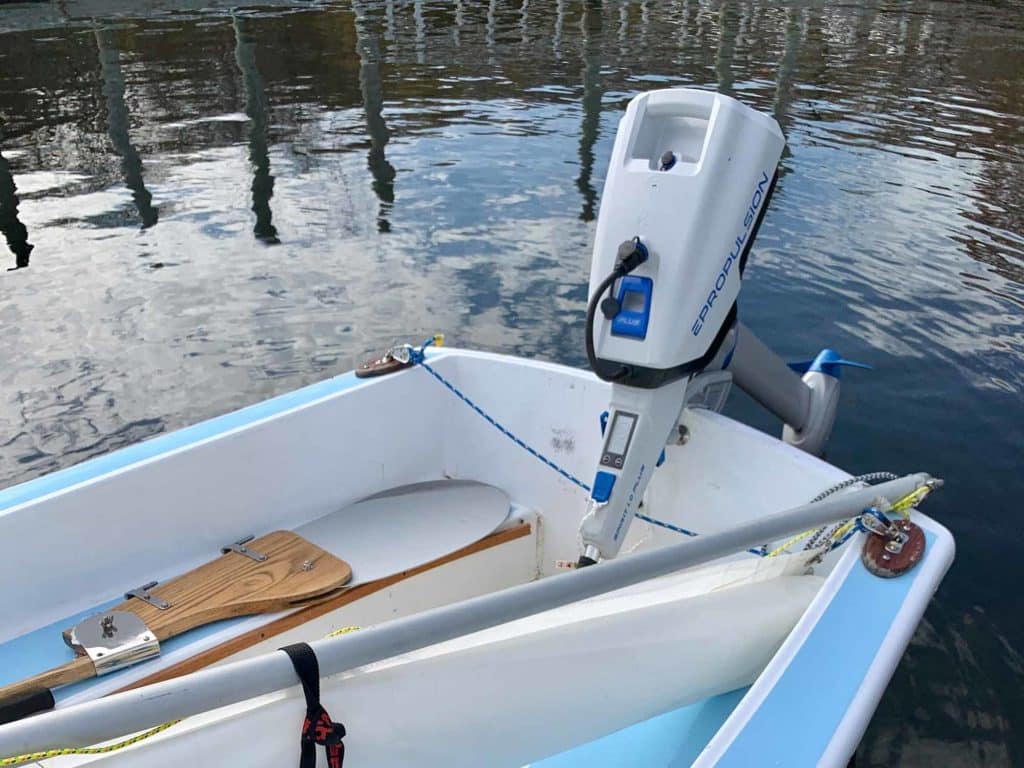
Those familiar with the O’Day Widgeon know of its chubby cheeks and flat rocker. It’s built for ponds and lakes, not this Southern Ocean stuff. With each pounding wave, the 50-year-old hull shudders, the aluminum mast flexes and the tired wire rigging goes limp. Wifey not happy. Neither am I.I can see the tall white-tipped pilings of the boat ramp in the distance, but between here and there are all white horses.
“It’s a good thing we have the outboard,” I repeat aloud, again, glancing nervously back at the LCD readout. We’re sucking wattage like a starving pig at a trough. “It says we have 45 minutes left. We’ll be fine, though.”We’re doing about 2 knots as I weave through the waves, trying to take them broadside. A few crash over the low cockpit coaming and fill the boat with cool seawater. I’m harboring a tinge of doubt, but once around another sharp bend in the channel, we’re able to flee to flatter water along the shoreline. I have no idea how shallow it is, but I’m not concerned; the outboard has a beaching pin that I’ve removed. Should we hit, it’ll pop up to prevent further damage to the prop and drive unit.
Once in the flat water, our speed resumes to a happy 3 knots, which seems to be terminal velocity for this particular Spirit 1.0 Plus/Widgeon combination. Eventually, I cruise up to the boat ramp’s tie-up dock; twist the throttle to neutral as I glide alongside and then twist the throttle the opposite way for the reverse gear. Yes—reverse in the tiller throttle. The boat drifts alongside gracefully, and I look at my watch to stop the tracking: 1 hour and 32 minutes.
It could have been hours—or days—more before we saw our children if not for the Spirit Plus saving the day.I don’t even need to ask my wife what she thinks of it. Her opinion comes unsolicited the moment she jumps onto the dock: “I love that thing,” she says, referring to outboard, of course. “You don’t have to give it back, do you?”
“I’m not sure,” I reply. “But I hope not. I will say, it sure is nice to have an outboard when you need it.” It only took this one trial to convince me an electric outboard is a no-brainer for small-boat sailing adventures. Yes, the piece of mind knowing it can help get me out of a pinch is one reason, but there’s also the obvious benefits: no gas, no mess or winter servicing. Best of all, though, there’s never any obnoxious engine noise spoiling the serenity, and that’s why we go sailing in the first place, right?

